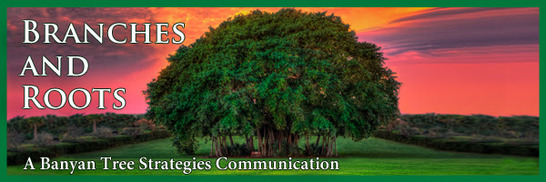|
"Branches & Roots": A Look at Strategy and Competition Through the Lens of Business and Sport A Banyan Tree Strategies Communication "Citius, Altius, Fortius"; Learning How to Compete With Your Best Self as a Team, a True Challenge Welcome to the second quarter of the year and the beginning of the last 45-days where work is still at the top of everyone’s priority stack. Your efforts to make 2016 a success should be in full swing and with a good start under their belts, many will be looking to stay the course. It is at this exact moment that quite a bit of self-sabotage occurs as we look to strike a balance between overdoing it, letting off the gas too much, and losing our momentum. Thousands of athletes are counting down the days to the 31st Olympiad in Rio; many are swift, others are strong, and all are focused. Yet how will they spend the next 124 days competing with their best self and for those of us competing in the Olympics of life, how do we keep the flame of inspiration and effort lit over the long haul? Having great relationships with others who we share commonalities in genes, interests, and abilities has shown to enhance the quality of our existence. Coming together as a group to form a cohesive team also helps us all to strive with. Striving with, or being with are common origins of the word “Competition” and in this issue we are going to look at concepts like culture, influence, and agreement as outcomes that can be improved when the principles of striving with are implemented. Speaking of competition, The Masters is this week and we end with a golf viewing tip for you, as the splendor of Augusta National hits your television. Is Your Culture a WOW! Or a Whatever? One of the benefits of helping companies work on turning groups of people into teams is that you get to visit a wide variety of settings and environments. A recent trip to a professional college had us buzzing and prompted the above title. This team of 125 teachers, administrators, and service staff were on fire from the very beginning of the two-day long all-hands meeting all the way until the end. Every member of the team was making a sacrifice to be present, and the business itself was closed the entire time. Thinking of the total cost to the enterprise would make most owners blink, yet like clockwork for years these days are reserved to fill up the tanks of the people that make the company tick. If your current culture is more of a Whatever these days than a Wow, see if implementing a few of these tips we gleaned will help. An initial idea to consider is having a common way to signal the end of a situation or event. Most companies will have gatherings, and even with the best clock management they can run long. With attention spans waning you increase the chances of having the end of your meeting being a dud, which sends your people scattering and potentially lacking vigor. Consider having something everyone does together to officially signal moving on to the next task. Think of a football team clapping their hands as they break the huddle. Your group should have its own authentic act, but as corny as it sounds it brings your people together. Another tip is to allow your long standing employees to talk about their experiences at the company. You will be shocked at how seriously they will take this, and it signals to everyone that commitment to the company is honored and appreciated. You needn't have a perfect culture to accomplish this, and the people you are honoring will have had challenges along the way. Regardless, this ceremony binds your people to each other and your enterprise. Finally, give your new employees a chance to answer a few key questions in front of the group, and make sure they are made to feel very welcome. One of the questions can be serious enough to let the entire group know that not just anyone qualifies to be on this team, and we are all looking to make a contribution. We really liked the question; what do you intend to contribute to our purpose, mission, and objectives? As newcomers stand in front of a group of warm fellow teammates and are given a resounding ovation after they share their answer, you are well on your way to having a culture of Wow vs Whatever. Here is a short video about how Zappos built a culture of Wow in Las Vegas where the call center employees are motivated to keep customers on the phone longer…. Your Moment For Maximum Influence This summer in Rio there will be moments where everything will be on the line and an announcer will say that the athlete will have to live with the consequences of the outcome for the rest of their lives. In almost all cases there will be only one gold medal awarded and the winner will have a moment that makes the difference in their victory. The tension captivates millions of viewers around the world, yet what about our lives and careers, do we have similar moments? We believe you do, and would like to outline two situations that you can look for to increase your ability to influence positive outcomes for your team. The first moment occurs when a potential customer responds to your company's offer with a standard “no thank you” objection. Very few customers answer in the affirmative when first approached, and most offer a common objection. Unfortunately, many people within the company and even the sales people accept the response as a final adjudication. This may not be the final javelin throw in the Olympics, but it is still a moment for maximum influence because the candidate has engaged you in dialog by responding to your offer with a no. You have a split second to keep them in dialog and inside your funnel of potential customers, or risk having to come back and restart the process, and take the chance to get a second no out of them. Rational people are happy to say no once, but repeating themselves on any matter is certain to draw their ire. It is at this moment of “no thank you I already have a cpa” that your team should have planned out a few key statements that will allow the prospect to look at their needs in a new light. Winning in this setting is not an accident, good teams plan through the standard responses, have them cataloged and are prepared to keep a prospect in dialog just long enough to either move to the next step or establish clearly that they are not a prospect. The second area is a derivative of the first, and has to do with how long it takes an organization to respond to a potential conflict or disagreement. If you are seeking advancement it is great to be known as someone who easily handles conflict without losing their cool. This is especially true if you are not endowed with great authority inside the group. A low power person who can navigate a disagreement between two parties is a future leader, and a company that addresses conflict quickly is going to outpace a similar company that prefers to bury their issues and hope they will disappear. Having an eye for advancement and an ear for conflict should be accompanied with some training on how to maintain mutual respect and agree to mutual purpose, and in all cases keep the dialog safe. In short, do not run into a burning building without a plan. Yet conflicts occur every day and being equipped to handle them will present you with moments for maximum influence. Getting to Agreement When We Don’t Even Celebrate the Same Way No better example of culture clashes that make you fall out of your chair laughing exists than “My Big Fat Greek Wedding”. The image of the parents of the groom showing up to the “let’s meet the other family before the wedding party” with a bundt cake still makes us chuckle. But what about when things are a little tenser and the stakes are higher? Dr. Erin Meyer has a new short videoout on how we can improve our chances of working with other cultures and it begins by seeing and understanding the habits of other cultures when it comes to things like celebration and disagreement. Given the diversity of most work forces, sharing insight with your team about these fundamental differences should go a long way towards allowing everyone to agree, even when we might express our agreement differently. What to Look For After Your Favorite Golfer Has Driven Down Magnolia Lane Next week 92 golfers will be searching for their highest and best self to appear in an effort to wear a most coveted green jacket, and pick the menu for next year’s champion’s dinner at the Augusta National Golf Club. The rest of the golfing world will be watching in earnest to see who has the goods to get past Amen corner and close the deal to win the first men’s major of 2016. If you are fortunate enough to watch the CBS broadcast we suggest you pay particular attention to the dialog between the player and their caddy when they are picking a club. Golf at its highest level requires precise touch in the midst of a mildly violent act. Moving a stick around your body in such a way as to propel a golf ball hundreds of yards and to have it stop where you want it requires an athlete to have above all things; rhythm. One of the places we build rhythm is in the cadence of communication and movement prior to getting set over a shot, and that place can be a swamp of confusion when it comes to what club to hit and how to hit it. Recent brain science is starting to show what part of the brain is working when we are thinking, speaking and visualizing. The question that our athletes appear to be answering for us as they play Augusta National is which part of the brain produces the best result. So this week as you are watching the telecast, tune out what the broadcasters are saying and see if you can watch the body language of the player and how it changes when they find it easy to get to a number vs when it takes them longer. If you spot something cool, make sure to email us and share your findings. We will be curious how long it takes Jason Day to get into the shot, he does a lot of eye fluttering. We will be listening to Phil Mickelson talk it up with Bones, he has a high twitch brain. In the end, we will also be listening to and rooting for Jordan Speith, he rolls his ball with purpose.  Our new book is out on Amazon! Get organized for life and work at TheNextGenAlmanac.com
0 Comments
Your comment will be posted after it is approved.
Leave a Reply. |
Archives
November 2023
Categories
All
Complete Annual Newsletter Volumes
|

